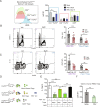The Maresin 1-LGR6 axis decreases respiratory syncytial virus-induced lung inflammation
- PMID: 36595677
- PMCID: PMC9926266
- DOI: 10.1073/pnas.2206480120
The Maresin 1-LGR6 axis decreases respiratory syncytial virus-induced lung inflammation
Abstract
The resolution of infection is an active process with specific molecular and cellular mechanisms that temper inflammation and enhance pathogen clearance. Here, the specialized pro-resolving mediator (SPM) Maresin 1 (MaR1) inhibited respiratory syncytial virus (RSV)-induced inflammation. inlerleukin-13 production from type 2 innate lymphoid cells (ILC) and CD4 T helper type 2 cells was decreased by exogenous MaR1. In addition, MaR1 increased amphiregulin production and decreased RSV viral transcripts to promote resolution. MaR1 also promoted interferon-β production in mouse lung tissues and also in pediatric lung slices. MaR1 significantly inhibited the RSV-triggered aberrant inflammatory phenotype in FoxP3-expressing Tregs. The receptor for MaR1, leucine-rich repeat-containing G protein-coupled receptor 6 (LGR6), was constitutively expressed on Tregs. Following RSV infection, mice lacking Lgr6 had exacerbated type 2 immune responses with an increased viral burden and blunted responses to MaR1. Together, these findings have uncovered a multi-pronged protective signaling axis for MaR1-Lgr6, improving Tregs's suppressive function and upregulating host antiviral genes resulting in decreased viral burden and pathogen-mediated inflammation, ultimately promoting restoration of airway mucosal homeostasis.
Keywords: CD4 T helper type 2 cells; innate lymphoid cells; regulatory T cells; resolution of inflammation; specialized pro-resolving mediators.
Conflict of interest statement
The authors declare competing interest. The authors have patent filings to disclose. B.D.L. is an inventor on patents (resolvins) assigned to Brigham and Women's Hospital (BWH). His interests were reviewed and are managed by the BWH according to conflict of interest policies. The other authors have no conflicts of interest to declare.
Figures






References
-
- Coultas J. A., Smyth R., Openshaw P. J., Respiratory syncytial virus (RSV): A scourge from infancy to old age. Thorax 74, 986–993 (2019). - PubMed
-
- Ramaswamy M., Groskreutz D. J., Look D. C., Recognizing the importance of respiratory syncytial virus in chronic obstructive pulmonary disease. COPD 6, 64–75 (2009). - PubMed
Publication types
MeSH terms
Substances
Grants and funding
LinkOut - more resources
Full Text Sources
Medical
Molecular Biology Databases
Research Materials

